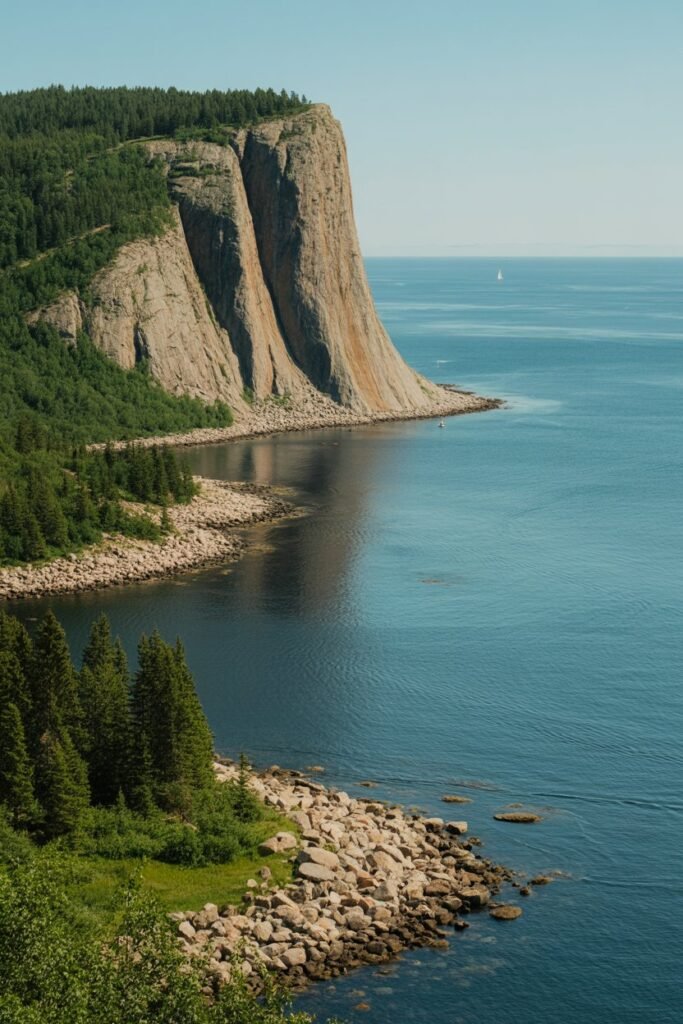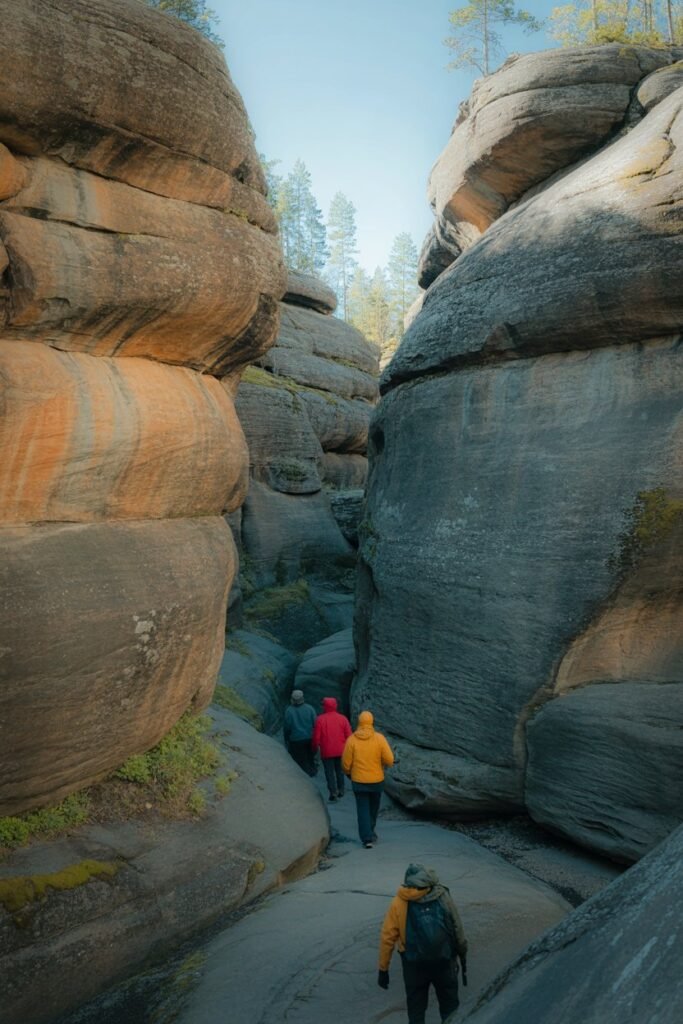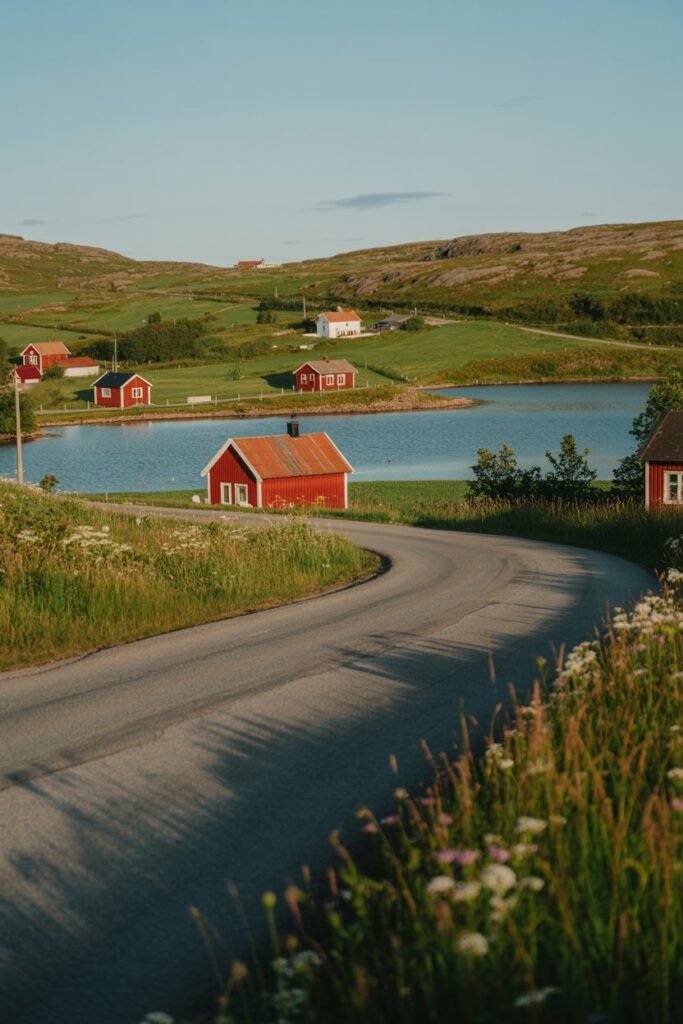Estimated reading time: 17 minutes
Key Takeaways
- The High Coast (Höga Kusten) is a UNESCO World Heritage Site known for its unique geological feature of isostatic rebound – the highest post-glacial land rise in the world.
- The High Coast Trail (Höga Kustenleden) spans 128 km and offers diverse terrain for both day hikers and multi-day trekkers.
- Skuleskogen National Park is a must-visit for nature lovers, featuring the dramatic Slåttdalsskrevan canyon and rich biodiversity.
- The Höga Kusten Bridge provides stunning viewpoints of the Baltic Sea and surrounding landscapes.
- Summer (June-August) is the ideal time to visit for optimal hiking conditions and extended daylight hours.
Table of Contents
- Introduction
- Overview of the High Coast Region
- Top Hiking Trails in the High Coast
- Höga Kusten Bridge Viewpoints
- Scenic Drives on the Swedish High Coast
- Practical Tips for Visitors
- Frequently Asked Questions about High Coast Sweden
- Conclusion
Introduction
The High Coast (Höga Kusten) region in Sweden stands as one of the country’s most remarkable natural treasures. This UNESCO World Heritage Site offers visitors an extraordinary mix of dramatic landscapes, rugged terrains, and some of the best hiking trails in High Coast Sweden. Located along the northeastern coastline, this geological wonder features steep cliffs, dense forests, and a unique archipelago that beckons nature enthusiasts and outdoor adventurers alike.
What makes this region truly special is its extraordinary geological history. Here, the land continues to rise from the sea in a phenomenon known as isostatic rebound, creating a constantly evolving landscape that tells the story of Earth’s natural processes. For hikers, photographers, and nature lovers, the High Coast provides an unmatched opportunity to experience Sweden’s natural beauty in its most raw and magnificent form.
Whether you’re planning to trek along marked paths, drive scenic coastal routes, or simply take in the breathtaking views from the iconic Höga Kusten Bridge, this guide will help you discover the wonders of this unique UNESCO site. If you’re planning a broader trip, our Sweden Travel Guide covers itineraries, top sights, and practical tips to help you explore more destinations across the country.
Want to see this for yourself? Click here to watch the Swedish High Coast in UHD 4K Resolution
Overview of the High Coast Sweden UNESCO Site
Where is the High Coast, Sweden, UNESCO site located?
The High Coast stretches along the Gulf of Bothnia in northeastern Sweden, extending approximately 100 kilometers from Härnösand in the south to Örnsköldsvik in the north [SOURCE]. This area is internationally recognized for its unique geological features, most notably the phenomenon of isostatic rebound.
What makes this natural process so remarkable here is that the High Coast has experienced the highest post-glacial rebound in the world, with land rising about 8 mm annually. Since the last ice age, the land has risen nearly 286 meters, dramatically transforming the landscape [SOURCE]. This continuous geological process has created a striking topography with hills, valleys, and coastal features that tell the story of the Earth’s recovery from massive ice sheets.
UNESCO World Heritage Status
In recognition of its exceptional geological value, the High Coast was designated a UNESCO World Heritage Site in 2000 [SOURCE]. The designation acknowledges both the scientific importance of the area’s post-glacial rebound and the unique aesthetic qualities of its landscapes.
The UNESCO site covers approximately 142,500 hectares, including both land and marine areas. This protection helps preserve the region’s natural character while allowing visitors to experience its wonders through sustainable tourism practices. For more cultural highlights and must-see landmarks, see our Sweden Tourist Attractions Guide, which includes castles, cities, and natural wonders across the country.
Landscape and Ecology
The High Coast features an incredibly diverse landscape that includes:
- Steep rocky cliffs that plunge into the Baltic Sea
- Dense coniferous forests cover hills and valleys
- A stunning archipelago with hundreds of islands and islets
- Sandy beaches and pebble-covered coves
- Unique geological formations like rounded mountaintops and ancient shorelines
This varied terrain supports a rich ecosystem with distinctive flora and fauna. The mix of coastal and forest habitats creates niches for numerous plant species, including rare alpine plants that have survived since the glacial period [SOURCE].
Wildlife in the region includes moose, deer, foxes, and various bird species. The coastal waters are home to seals and diverse marine life, contributing to the area’s ecological importance. The interplay between land and sea creates a dynamic environment that continues to evolve as the land rises from the water.
Visitors to Sweden’s High Coast region often describe the landscape as hauntingly beautiful – a place where you can literally witness the results of geological processes that usually take place over timescales too vast for human perception.

Best Hiking Trails & Swedish High Coast Trail Guide
Höga Kusten Hiking – Best Sections of the High Coast Trail
The High Coast offers some of the most spectacular hiking opportunities in all of Scandinavia. From leisurely day walks to challenging multi-day adventures, these trails showcase the region’s dramatic landscapes and natural beauty.
The crown jewel of hiking in the region is the High Coast Trail (Höga Kustenleden), an impressive 128-kilometer route that winds through the heart of this UNESCO World Heritage Site [SOURCE]. This well-marked trail is divided into 13 sections, making it accessible for both day hikers and those looking to tackle the entire route over 5-7 days.
The High Coast Trail offers incredible variety, taking hikers through:
- Ancient forests with moss-covered stones
- Coastal sections with sweeping Baltic Sea views
- Rocky hills provide panoramic vistas
- Quiet beaches and fishing villages
- Areas where visible ancient shorelines tell the story of the land’s rise
For day hikers, popular sections include the trails around Skuleberget mountain and the paths connecting the villages of Bönhamn and Barsta. These shorter routes offer a taste of the High Coast’s beauty without committing to the full trail.
Along the route, hikers will find basic shelters, camping areas, and occasional guesthouses. The trail is generally well-maintained, though some sections feature challenging terrain with steep ascents and rocky paths that require proper hiking gear.
Skuleskogen National Park Hiking on the High Coast, Sweden
Skuleskogen National Park is the jewel in the crown of the High Coast region and a must-visit destination for hiking enthusiasts [SOURCE]. Established in 1984, this 30-square-kilometer park showcases some of the most dramatic landscapes in the entire High Coast.
The park’s centerpiece is the famous Slåttdalsskrevan, an impressive canyon formed by ancient geological forces. This massive crevice cuts through the mountain, creating walls up to 40 meters high and just 7 meters wide at certain points. Standing inside this natural formation gives visitors a profound sense of the powerful forces that have shaped this landscape [SOURCE].

Skuleskogen offers several well-marked trails of varying difficulty:
- The South Entrance Trail (4 km): A relatively easy path suitable for most visitors
- The Slåttdalsskrevan Trail (5 km): Moderate difficulty, leading to the famous canyon
- The North-South Trail (9 km): A more challenging route crossing the entire park
The park’s diverse ecosystem supports a rich variety of wildlife. Lucky hikers might spot moose, deer, or even the rare lynx. The forest floor is home to blueberries and lingonberries in season, while various alpine and coastal plants thrive in this unique environment where mountain meets sea.
For those looking to experience Sweden’s natural attractions, Skuleskogen provides well-maintained facilities including restrooms, information centers at main entrances, and designated camping areas. The park is accessible year-round, though winter visits require additional preparation and proper equipment. Looking for more epic hikes in Scandinavia? Our Hiking in Norway Guide features waterfalls, national parks, and scenic trails that pair well with a High Coast adventure.
Höga Kusten Bridge Viewpoints & Things to Do on the High Coast, Sweden
Vantage Points and Scenic Views
The Höga Kusten Bridge (Högakustenbron) is not just a transportation link but a striking architectural landmark and one of the region’s most photographed sites [SOURCE]. Completed in 1997, this suspension bridge spans 1,867 meters across the Ångermanälven river, with its towers reaching an impressive height of 180 meters.
The bridge serves as both a gateway to the High Coast region and a spectacular viewpoint in itself. Visitors can access several official viewpoints that offer different perspectives of this engineering marvel:

- Veckobladet Viewpoint: Located on the southern side, this easily accessible spot provides classic views of the bridge against the backdrop of the Baltic Sea.
- Hornöberget: A slightly elevated position offering broader panoramic views of the bridge and the surrounding landscape.
- Ramberget: For those willing to hike a bit, this hill provides a higher vantage point with sweeping views of the bridge, river, and coastal landscape.
Each viewpoint offers unique perspectives, allowing photographers and nature lovers to capture the bridge in different lighting conditions and against varying backdrops. The bridge itself is illuminated at night, creating striking photo opportunities against the dark Nordic sky.
Photographic Opportunities
For photography enthusiasts, the Höga Kusten Bridge provides endless creative possibilities. The structure’s elegant design contrasts beautifully with the natural surroundings, creating compelling compositional opportunities. Another city filled with striking photo opportunities is Gothenburg, Sweden, where coastal views and cultural attractions blend seamlessly.
The best times for photography include:
- Early morning: When mist often hangs over the water, creating ethereal scenes
- Golden hour: Both sunrise and sunset cast warm light on the bridge’s surfaces
- Clear winter days: When the snow-covered landscape creates a stark contrast with the bridge
When visiting the bridge viewpoints, bring a wide-angle lens to capture the entire structure and its surroundings. A telephoto lens can also be useful for isolating details of the bridge against the backdrop of the Baltic Sea or focusing on ships passing underneath.
The area around the bridge also features several hiking paths that lead to less-visited viewpoints. These trails offer opportunities to discover unique angles and perspectives that showcase both the natural beauty of the High Coast and the architectural achievement of the bridge.
For those exploring Sweden’s coastal areas, the Höga Kusten Bridge viewpoints provide an excellent starting point for discovering the region’s unique blend of natural and human-made wonders.
Scenic Drives & Things to Do Along the Swedish High Coast
Recommended Drives
While hiking may be the most celebrated way to experience the High Coast, scenic drives offer a wonderful alternative for exploring this stunning region. The winding coastal roads reveal breathtaking vistas at every turn, making a road trip along the High Coast an unforgettable experience. If road trips are your style, check out our Great Ocean Road Itinerary in Australia — another breathtaking coastal drive with viewpoints at every turn.
The E4 Coastal Road serves as the main artery through the region, offering spectacular views as it winds along the coastline [SOURCE]. This well-maintained highway features numerous pull-offs and viewpoints where travelers can safely stop to admire the scenery. Highlights along this route include:
- Barsta Fishing Village: A picturesque stop with traditional red wooden houses and a charming harbor
- Docksta Viewpoint: Offering panoramic vistas of the coastline and surrounding hills
- Skuleskogen Lookout: A roadside stop with views of the national park’s forested hills
For those seeking more intimate driving experiences, several smaller roads branch off from the E4, leading to hidden coves, quiet villages, and secluded viewpoints. The road to Norrfällsviken, for example, takes drivers through lush forests before opening up to reveal stunning coastal landscapes and a historic fishing hamlet.
Another recommended drive is the circular route around Nordingrå, often called the “High Coast Pearl” for its concentration of beautiful landscapes. This drive passes several small lakes, traditional farmsteads, and rolling hills that showcase the region’s diverse terrain.

Experience and Exploration
One of the advantages of exploring the High Coast by car is the ability to easily access the region’s scattered islands and coastal villages. Ferry connections from Docksta and Ullånger allow drivers to visit islands like Ulvön, known for its preserved fishing village and famous fermented herring, and Trysunda, with its pristine beaches and nature reserves.
These island excursions offer a glimpse into traditional coastal life and provide opportunities to experience Sweden’s maritime heritage firsthand. Many islands feature small restaurants serving fresh local seafood, making them perfect lunch stops during a day of exploration.
The coastal drive also connects visitors to smaller villages that might be missed by those focusing solely on hiking trails. Places like Bönhamn, Mjällomslandet, and Skagsudde each have their own character and charm, from historic lighthouses to artisanal food producers and craft workshops.
For those interested in the region’s cultural heritage, the drive between Härnösand and Örnsköldsvik includes several sites of historical interest, including ancient burial grounds, 19th-century churches, and traditional farmsteads that offer insights into the area’s past.
A scenic drive through the High Coast complements hiking activities, allowing visitors to cover more ground and discover the broader context of this remarkable region. With well-maintained roads, clear signage, and relatively light traffic outside the peak summer season, driving here is both pleasant and rewarding for those looking to experience Sweden’s scenic landscapes from the comfort of their vehicle.
Practical Tips for Visitors
Best Time to Visit
The High Coast experiences distinct seasons, each offering a different perspective on its natural beauty. However, for most visitors, certain times of year provide optimal conditions for exploring this unique UNESCO site.
Summer (June to August) is widely considered the ideal time to visit the High Coast [SOURCE]. During these months, visitors can enjoy:
- Long daylight hours (up to 20+ hours of light), maximizing exploration time
- Pleasant temperatures typically ranging from 15-25°C (59-77°F)
- Lush green forests and wildflowers in full bloom
- Optimal conditions for hiking, swimming, and boating
- All visitor facilities, accommodations, and restaurants are operating at full capacity
Late spring (May) and early autumn (September) can also be excellent times to visit. These shoulder seasons offer fewer crowds while still providing generally favorable weather conditions. September in particular brings beautiful fall colors to the forests, creating spectacular scenery for photographers.
Winter visits (November to March) are possible but require additional preparation. While the snow-covered landscape has its own stark beauty, many trails become difficult to navigate, daylight hours are limited, and most tourist facilities operate on reduced schedules or close entirely.
Gear and Safety
Proper preparation is essential for safely enjoying the High Coast’s natural attractions [SOURCE]. Visitors should consider packing:
- Sturdy hiking boots with good ankle support and grip for navigating rocky trails
- Layered clothing, even in summer, as the weather can change quickly in coastal areas
- Waterproof jacket and pants, as rain showers can occur year-round
- Sun protection, including sunscreen, a hat, and sunglasses
- Insect repellent during the summer months when mosquitoes can be active
- Map and compass or GPS device, as mobile coverage can be spotty in remote areas
- Water bottle and filtration system if planning to use natural water sources
- First aid kit with basic supplies for minor injuries
When hiking in the High Coast region, always inform someone of your planned route and expected return time. Many trails have variable terrain, including steep sections and slippery rocks that require careful navigation.
Be aware of local wildlife, including moose and occasionally bears. While dangerous encounters are rare, knowing proper wildlife safety procedures adds an extra layer of security during your adventures.
Local Regulations
The High Coast’s status as a UNESCO World Heritage Site and its natural reserves come with certain regulations designed to preserve its unique environment for future generations.
Sweden’s “Allemansrätt” (Right of Public Access) allows visitors considerable freedom to enjoy nature, but it also comes with responsibilities:
- You may walk, hike, and temporarily camp on most land that isn’t private property or cultivated
- Fires are only permitted in designated areas, and may be prohibited entirely during dry periods
- All trash must be packed out – leave no trace of your visit
- Respect wildlife and plant life – don’t disturb animals or damage vegetation
- In national parks like Skuleskogen, additional rules may apply regarding camping locations and activities
In protected areas, visitors should stay on marked trails to minimize impact on sensitive ecosystems. Many rare plant species grow in the High Coast region, and their conservation depends on responsible tourism practices.
Most visitor centers provide detailed information about current regulations, which may vary seasonally. Taking time to understand these guidelines ensures both your safety and the preservation of this remarkable natural heritage for visitors exploring Sweden’s diverse regions.
High Coast Sweden FAQs – Hiking, Itinerary & Things to Do
When is the best time to visit and hike the High Coast region?
The best time to visit and hike the High Coast in Sweden is during summer, from June to August, when trails are fully accessible, daylight lasts up to 20 hours, and temperatures range from 15–25°C. May and September are also good, with fewer crowds and mild weather. Winter hikes are possible but more challenging, requiring proper equipment for snow and limited daylight.
What are the most popular hiking trails and routes on the High Coast in Sweden?
The High Coast Trail (Höga Kustenleden) is the region’s most popular route, stretching 128 km across diverse terrain and divided into 13 sections. Other highlights include Skuleskogen National Park, home to the dramatic Slåttdalsskrevan canyon, and shorter routes around Skuleberget, Bönhamn, and Barsta, which are perfect for day hikers seeking scenic views without committing to multi-day treks.
How difficult are the hiking trails in Skuleskogen National Park on the High Coast?
Skuleskogen National Park on the High Coast offers hiking routes for all levels. The South Entrance Trail is a relatively easy 4 km walk suitable for families. The Slåttdalsskrevan Trail is moderate at 5 km, leading to the canyon. More advanced hikers can take the 9 km North-South Trail across the park. Terrain can be rocky and steep, so sturdy hiking boots and good fitness are recommended.
Can you drive and explore scenic routes along Sweden’s High Coast UNESCO site?
Yes, the E4 Coastal Road is the main scenic drive through the UNESCO-listed High Coast, with viewpoints like Docksta and Barsta Fishing Village. For a more immersive route, the Nordingrå loop showcases rolling hills, lakes, and fishing hamlets. Drivers can also reach islands such as Ulvön and Trysunda via ferries, making road trips an excellent way to combine landscapes, culture, and coastline.
What should I pack for hiking trips on the High Coast, Sweden trails?
Pack sturdy boots, layered clothing, and waterproof gear for High Coast Sweden trails, as weather changes quickly. A map or GPS is essential since coverage can be limited. Bring insect repellent in summer, sun protection, and a refillable water bottle. For longer hikes, carry camping equipment or use shelters along the Höga Kusten Trail. A small first-aid kit and snacks will help ensure a safe and enjoyable experience.
Conclusion
The High Coast of Sweden stands as a living example of how geological forces continue to shape the land. Its UNESCO World Heritage designation highlights the value of this unique landscape, where mountains meet the Baltic Sea and ancient forests border rocky archipelagos.
Visitors can choose between long-distance treks on the High Coast Trail, shorter hikes in Skuleskogen National Park, or scenic drives that link coastal villages and viewpoints. Each experience offers a different perspective on the region’s evolving terrain.
Planning your trip around the summer months ensures favorable conditions, but every season brings its own atmosphere. Preparing with the right gear and awareness of local regulations will help you explore safely and responsibly.
The High Coast can also be combined with other northern Sweden destinations, creating a wider itinerary that balances coastlines, wilderness, and cultural sites. For more travel inspiration, explore related guides across Scandinavia and discover how these regions connect into a broader journey.
We hope this guide helps you plan an unforgettable journey to this special corner of Sweden. For more inspiration on exploring the natural wonders of Scandinavia’s spectacular landscapes, visit Pathfinders Travel YouTube channel to watch stunning travel documentaries in 4K resolution showcasing the world’s most remarkable destinations.

